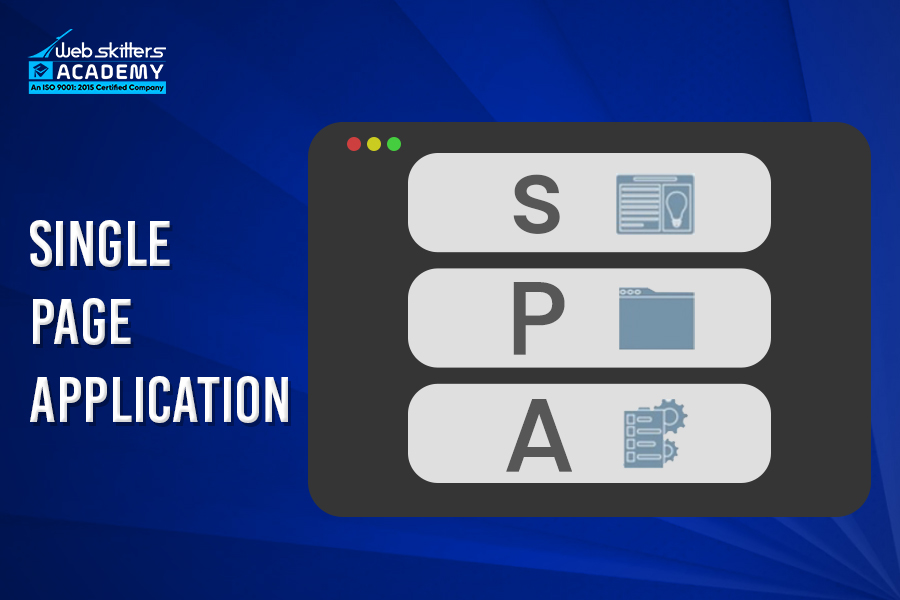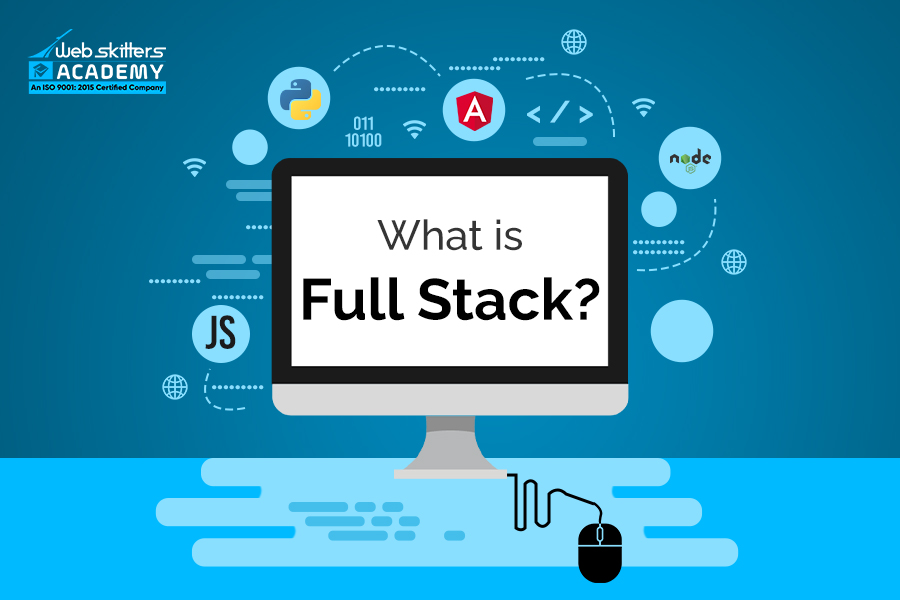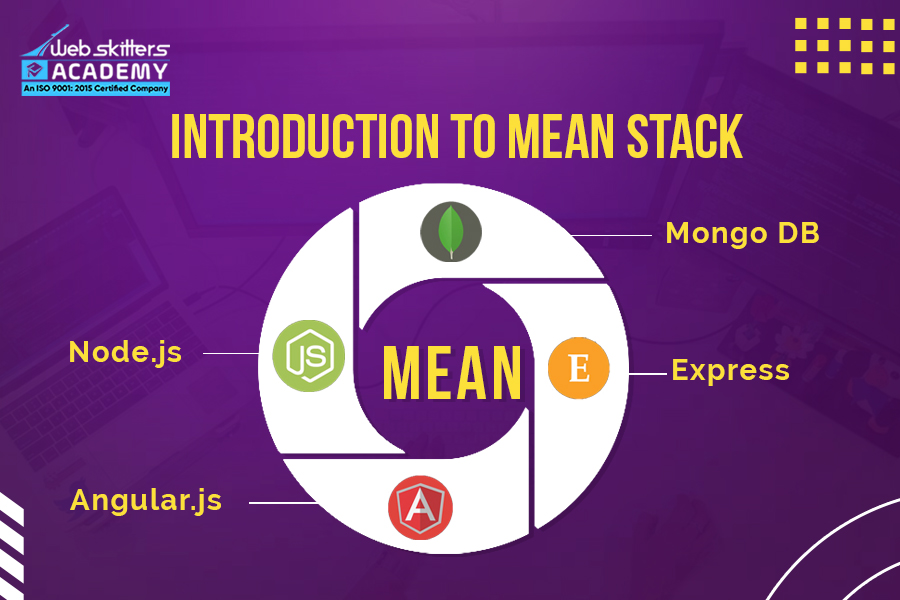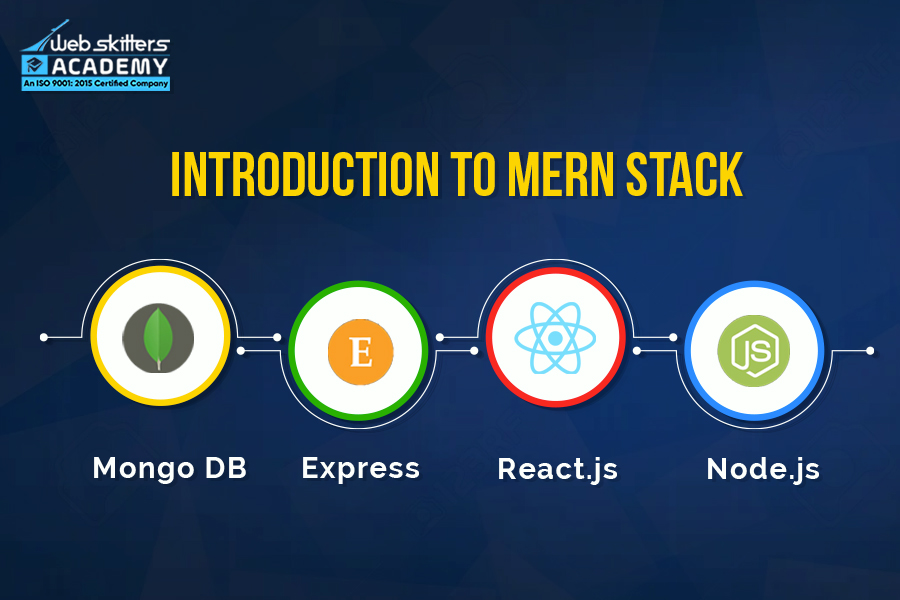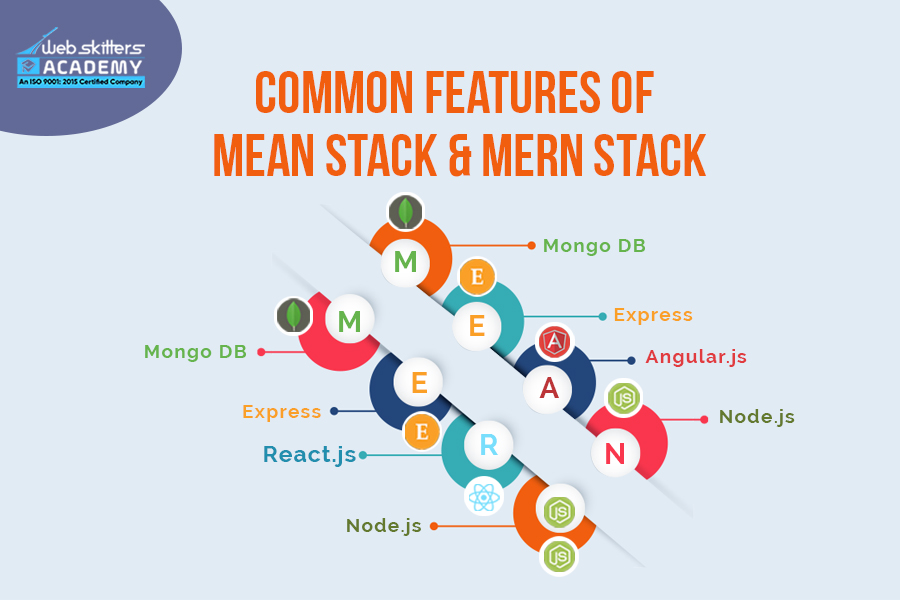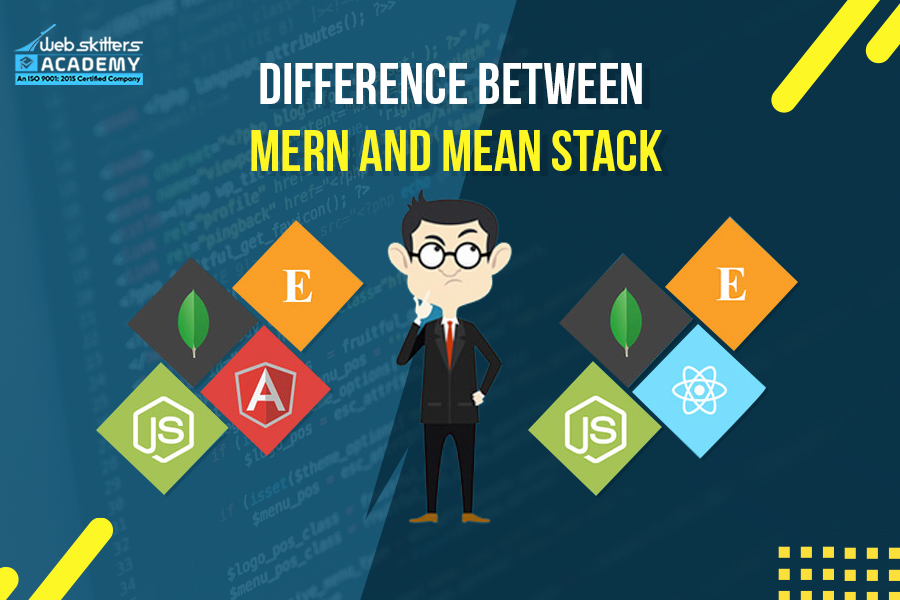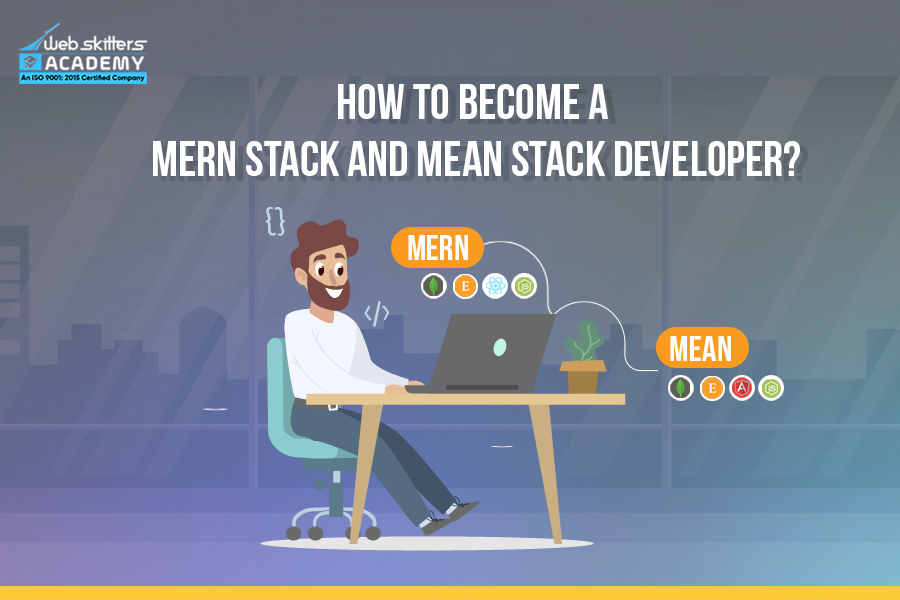
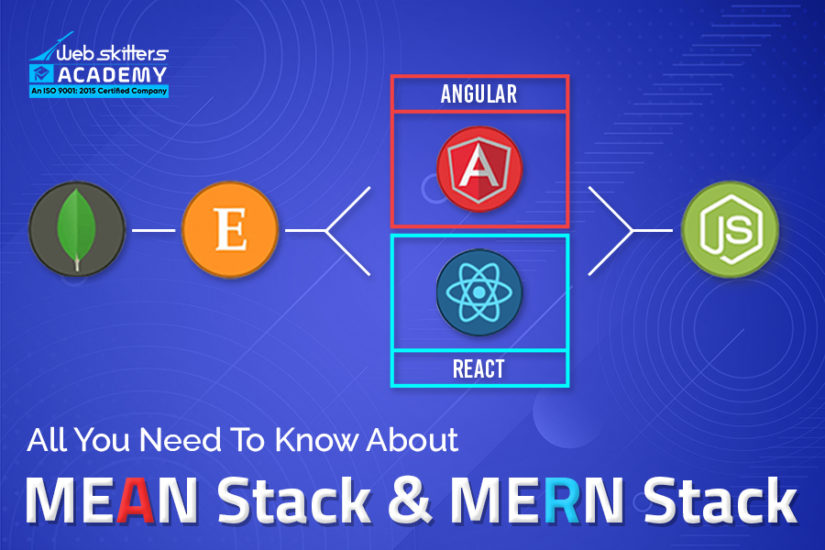
All You Need To Know About MEAN Stack & MERN Stack
Table of Contents
Are you trying to figure out which one is best in MEAN & MERN Stack?
Well, there are few things you must get yourself familiar with to have a clear idea about the entire concept.
Before digging into MEAN Stack vs MERN Stack, having a clear concept about the reason these stacks were created is important. But why these stacks were created on the first place?
These were created to build Single Page Applications also known as SPA successfully.
What Is Single Page Application?
Single Page Application is a web application that only requires a single page load while accessing through a web browser. This is a concise definition but the process required some more qualifications to be performed and executed effectively.
Web applications range from simple static website with a full-blown software like Google Maps or Flickr.
Why Go for Single Page Application?
The idea of single page application makes your browser blink once and load the complete page. It means you can view any page of that site without waiting for the site to load every time. In short, it loads the site along with its all the pages to modify them instantly in accordance of your preferences.
The entire process happens as after loading the site, background JavaScript performs the server interactions to modify the view as per requirements. At the writing time, Single Page Applications are known by their usage of the JavaScript framework.
The JavaScript framework enables the through techniques including templating, view to model binding and routing.
If the web apps are able to talk to the servers and update the views this has as two clear complications, then we have achieved huge wins on user experience and bandwidth improvement.
What Is Stack?
Stack is generally a combination of programming languages, software products or technologies. Development stack is also divided into two categories known as technology stack and application stack.
Now, the topic we are about to discuss today falls under the technology stack category. Apart from these, another technology stack is known as full-stack.
Before digging into MEAN Stack and MERN Stack comparison, what about discussing a bit about Full Stack and Mean Stack?
Now, full-stack developers are in huge demand as they are able to solve issues in different software development streams. Organizations are also interested in hiring full-stack developers because of their capabilities of building any website or mobile app from scratch.
What is Full-Stack?
It is almost impossible to develop software with the use of only one technology. A full-fledged software requires the use of “tech stacks”. A tech stack or technology stack is a common term used in the modern software and app development industry.
It is a combination of programming languages, databases, templates, libraries and other tools.
A full-stack is the collection of technologies needed for creating software successfully. It involves all the functions associated with the database, server, programming languages and more.
Full-stack development requires the developers to build software from scratch, covering both the frontend and backend with one tech stack.
Key Capabilities of Full-Stack Development:
Some of the major key capabilities of full-stack development include the following:
- Database- MongoDB, Clusters, MySQL, Postgres, SQLite among others.
- DevOps- CI/CD pipelines and Software Development Life Cycle (SDLC) formulation.
- Backend- Django, ExpressJS, NodeJS, Python, PHP, etc.
- Frontend- Angular, TypeScript, CSS, Single page applications (SPA) like HTML5 and JavaScript, React, etc.
How Is the Demand for Full-Stack Developers in The Market?
Their rare expertise and high versatility have created a huge demand for full-stack developers. From start-ups to MNCs, entrepreneurs are jumping to hire these developers. For their comprehensive skillset and excellent tech knowledge, these developers are known as the unicorns of the software industry.
They are capable of identifying and resolving flaws in different streams. Being technically skilled, they can easily identify a problem and provide a solution to it according to its architectural streams.
The popularity of these developers has flourished widespread. They can handle the project design structure and perform all development duties with their web and app architectural functions. A full-stack development guarantees an excellent performance, quick launch to the market, and ease of development, which is yet another reason for the high popularity of full-stack developers.
What Are the Advantages of Full-Stack Development?
As mentioned above, full-stack development helps a company receive excellent performance and swift launch to the market. But it has many other benefits for which it is popular in the industry. Let us check them out:
-
Easy to design and execute
The full-stack developers have in-depth knowledge of UI/UX design. They take ownership of the design structure. Implementation and execution of the design process are easy with a full-stack development process.
-
Affordability
Ensuring to use the full-stack development is an affordable measure on the part of the organization. With a full-stack development team, both front-end and back-end development procedures can be managed easily. There is no need to hire a separate team to take care of both phases.
-
Easy Switching
One of the biggest advantages of using full-stack development is it allows the coders to switch their work between the front-end and back-end at any time. Depending on the project’s requirement. It becomes easy for the developers to easily keep switching between both ends.
-
Easy to upgrade
Full-stack developers can easily catch up with the new techs and tools in the market. They are capable of adapting to the new technologies and tools faster than other developers, and hence it is easy for them to stay updated and upgraded.
Introduction to MEAN Stack
What is MEAN stack?
This stack is a combination of Mongo DB, Express.JS, Angular and Node JS. technologies for website and mobile app development. In general, this stack is used to build complicated websites and web applications. With the help of these JavaScript technologies, mean stack deployment architecture is prepared. It is used for complex development because Mongo DB, Express.JS, and NodeJS are based on JavaScript and Angular is based on TypeScript.
So, it helps to simplify and speed up the development process. It belongs to a category of the fastest-growing open-source development process as it offers popular tools and plugins for faster web application deployment.
Is MEAN a full-stack solution?
Yes, MEAN is a full-stack solution with a set of collected JavaScript-based technologies. It has MongoDB, Express JS, Angular and Node JS technologies to help develop complex websites and mobile and web applications.
These technologies simplify and accelerate the development of web, mobile and progressive app development.
Being one of the fastest-growing open stack development frameworks, MEAN allows quicker deployment of apps, APIs and websites and allows the developers to concentrate on the complex development process.
How Does the MEAN Stack Work?
MEAN Stack technologies are used in mobile and web applications. It is one of the fastest-growing open-source development frameworks that assist developers to reduce the time on system admin. In recent days, responsive web apps and some complex websites are built with mean stack, which is powered by this group of technologies.
MongoDB is used for the back-end application to store the data as JSON documents. The JSON document is created in the AngularJS front end and is sent to the Express JS server, where it can be processed and is then stored directly in MongoDB.
ExpressJS is a backend application framework that runs on top of NodeJS. It implies the APIs for accessing the database. It uses a particular API to call the database, depending on whether a user wants to store the data. This framework is known for being a fast and minimalist web framework for NodeJS. It is a powerful model for URL routing and handling HTTP requests and responses.
AngularJS is a front-end web app framework that runs your JavaScript code in the user’s browser, making the User Interface of your application dynamic. It also allows the developers to extend the HTML tags with metadata for creating an interactive experience for the users.
NodeJS is the JavaScript runtime environment that implements the backend of an application in JavaScript. It is the central part of the MEAN stack development as it handles the requests between the client and server-side.
When all these tiers function properly, MEAN Stack works offering full database security and cross-cloud scalability.
Why Choose the MEAN Stack?
MEAN Stack facilitates a unique environment for executing client-side and server-side programming. The demand for this stacking technology has also increased for its versatility in building web and mobile applications. The result of MEAN Stack development is fast, maintainable, and robust, thanks to the technologies that powers it.
Below are a few reasons why MEAN Stack is chosen by software developers and companies all across the world:
- MEAN Stack uses a single language throughout the development- client-side and server-side. All the components of MEAN are written in JavaScript, which makes the web development process neat.
- It facilitates isomorphic coding. Transfer of written code from one framework to another is easy with MEAN.
- Companies are looking for development frameworks and technologies that help them to achieve perfection in the development process of applications and websites. MEAN provides them with this facility.
- These stacks of technologies together are extremely flexible. It allows the developers to develop, test and launch the app to the market without any issues.
- Having a set of JavaScript technologies, all of which performs efficiently together, MEAN Stack has emerged as a cost-effective method for web app development.
- The non-blocking architecture of NodeJS allows MEAN stack development to get speedy and easily reusable.
- AngularJS, being an open-source JavaScript framework offers Testability, Maintenance and Reusability features.
- MEAN stack is compatible with cloud technologies. It uses cloud functionalities for reducing the space cost on the disk.
- It supports the MVC architecture, which is responsible for delivering quality user interfaces.
- The different components of MEAN are extremely popular. It offers constant global community support, which is a great help for the developers.
What Are the Advantages of The MEAN Stack for Web App Development?
The features of each of its components make MEAN a holistic stack for web development. Using the MEAN Stack components/technologies for the development of a web app provides the company with the following advantages:
-
The holistic and smooth development process
MEAN Stack uses a single language, JavaScript throughout the coding phase. With the same language being used in the client and server-side development, there are few or almost no hiccups during the development process. It makes the process smooth.
-
Active community for long-term support
JavaScript is one of the most common and highly-preferred programming languages in the market. Hence, it boasts an active developer community. If a JavaScript developer faces any problem, the community provides quick and easy support and solution.
-
Development is cost-effective
MEAN stack developers know their way through the frontend, backend and even database. They provide comprehensive web development services. They can complete the web app project all by themselves. The company need not hire developers for frontend and backend, separately. It saves their development costs by reducing the headcounts involved in the process. The combination so technologies involved with the MEAN stack also helps in keeping the development costs to a minimum.
-
Ease of isomorphic coding
One of the biggest advantages of using the MEAN stack for the development process is the ease of isomorphic coding that it offers. It means the code written in one framework can easily be transferred to another, without any hassle. It increases the productivity and speed of the project and also helps in ensuring better performance as the data transfer takes place in the JSON format. The isomorphic coding ability is also one of the most sought-after features you will come across in any mean stack job description.
-
High flexibility
The MEAN Stack developers have the access to build, test and introduce the app without any hassle. The flexible platform also allows the developers to test the application on a cloud platform. It is also easy for the developers to add any extra piece of information once they are done adding a field in the form. The MongoDB framework provides comprehensive cluster support and automatic replication feature, which further eases the process.
-
The quick and easy testing process
MEAN stack and its various components allow the developers to test an application on the cloud platform easily. MongoDB is specifically designed to make it easier for the developers to add an extra bit of information. It provides cluster support and automatic replication in the cloud, which fuels the development and testing process.
-
Cloud compatibility
MongoDB allows the developers to integrate cloud functionalities into the website. The development process under this stack makes the best use of libraries and public repositories that reduces the overall cost. Its various features and integrated characteristics make the MEAN stack compatible with the cloud.
-
JavaScript Object Notation (JSON)
JSON is present in MEAN stack development throughout the process. Angular and Node both offer JSON, MongoDB stores the data in JSON format, and it is also used by Express. The use of JSON in MEAN stack development facilitates the smooth data flow. There is no need for rewriting or reformatting in the different layers.
-
Swift development process
The flexibility of the MEAN Stack technologies fuels the development process. Its non-blocking architecture helps make it a speedy framework. Angular further confirms reusability and easy maintenance of codes on MEAN Stack.
What Are the Skillsets Required for Being a MEAN Stack Developer?
MEAN stack developers need to develop efficient and effective skills for building a bright future for themselves. For building the robust and real-time applications using these stack technologies, the following are the mean stack developer skills that the recruiters always look for-
- Basic understanding of architecture and workflow.
- The clarity to understand client-side processes and requirements.
- Gaining insight into the server-side processes and requirements.
- Familiarity with a package manager (node project manager).
- Knowledge of HTML, CSS, and JavaScript programming languages.
- Understanding of Git and design frameworks like MotionUI.
- Expertise in MEAN stack technologies- MongoDB, ExpressJS, AngularJS and NodeJS.
- Skills in CSS and JavaScript-based frameworks.
- Critical thinking, time-management and communication skills.
- Excellent research skills to identify a problem and find its specific issues.
- Understanding to operate under agile development methods.
What Does a MEAN Stack Developer Do?
Developers can create dynamic web applications and websites through the use of MEAN stack technologies. They can handle both the front-end and back-end of the development process, making it cost-effective for businesses. Let’s take a look at the roles and responsibilities that the MEAN Stack developers need to be acquainted with:
- Identify the application issues while deploying the apps.
- Building interactive data.
- Build, test and deploy scalable web apps.
- Design and maintain fully-functional relational and non-relational databases.
- Testing applications and fixing bugs with data protection features.
- Creating scalable RESTful APIs.
- Deploying apps on the cloud with solving debugging issues.
- Knowledge of mean stack cloud computing.
- Creating features in the app with mobile responsive design.
- Conducting code reviews.
- Timely deployment of web apps on the cloud.
- Coding frontend and backend architecture.
- Making use of popular front-end frameworks and designing UI components.
- Collaboration with IT team, designers and encouraging business goals.
- Establish code architecture decisions for good performance.
What Is the Salary of a MEAN Stack Developer?
The use of JavaScript makes Mean Stack a demanding field in the market. It provides great career opportunities and is also popular for its development toolkit that allows developers to create robust and dynamic web applications. Integration of both frontend and backend developments comes into play in Mean stack development.
It consists of various technologies that make it a versatile field for software engineers, software developers and web developers. The salary of a MEAN Stack developer highly depends on the skillsets possessed by the individual. Various factors such as location, company, skills and experiences govern the salary package.
The average salary of a fresher MEAN Stack developer in India can be expected to be around INR 2 to 2.5 LPA. As you grow in the field, your salary grows with you. A mid-level mean developer can earn anywhere around INR 4 and 6 LPA. When the experience level crosses 3 years, the developers can expect to earn around INR 6 and 9 LPA.
MEAN is one of the highest-paying jobs in India. If you have the right skills, you will have a salary that complements it.
What Is the Future of a MEAN Stack Developer?
There is a growing trend of using MEAN Stack web development courses in Kolkata for the frontend and backend development. The stack consists of all technologies that meet the requirement for the development of a fully efficient website.
For people seeking a strong career opportunity, MEAN Stack development is highly-desirable and challenging vocational. If you have the right skill sets and knowledge of various coding languages, then this is the right choice for you.
Being high in demand, the sector offers a successful and bright career. Having their specialization in both backend and frontend, and updated on the technologies, the demand is manifold. Earn recognition in web development and deliver cutting-edge applications.
Introduction to MERN Stack
What is MERN stack?
Just like MEAN Stack, MERN Stack is also a combination of technologies. It consists of Mongo DB, Express.JS, ReactJS, and NodeJS. It is these technologies that together creates the mern stack deployment architecture. This is a full-stack based on JavaScript, and it offers developers an end-to-end framework for the development process.
The basic difference between MEAN Stack and MERN Stack is React.JS and Angular. There are some common features of these stacks. Let’s get to know about them.
Is MERN a full-stack solution?
Yes, MERN is a full-stack solution. It follows the traditional 3-tier architectural pattern, which includes the front-end display tier, application tier, and database tier.
React JS works as the front-end display tier, MongoDB as the database tier and Express JS and Node JS as the application tier.
It is used for crafting premium software for a business. All the components provide end-to-end framework support for the developers and enable them to work excellently without facing any issues.
How Does the MERN Stack Work?
MERN is designed to make the application development process simpler and faster. Each component of MERN has its role to play in the development of your software. The web applications or websites built with mern stack, consists the features and benefits of the four technologies.
MongoDB is a cross-platform document-oriented database that offers a document model, which outlines the object in the code and makes data effortless to work with. It offers high availability, management tooling and end-to-end security.
ExpressJS is a backend application framework, which is used for NodeJS. It has multiple features that enable it to make web application development faster and simpler. It makes it easier for the developers to serve static resources and files of their applications.
ReactJS is an open-source front-end JavaScript library that plays a vital role in developing an attractive and interactive User Interface of software.
NodeJS is an open-source backend that generates dynamic content for web pages, manages files on the server or modifies data in the database.
All the components of MERN are useful even individually. But combining these components gives the developer an excellent way to build high-performing web applications and software.
Let us take a look at the functioning of all these components in a MERN stack application.
Hypothetically, let’s consider that you have developed an eCommerce application using MERN. Now, what happens when a customer visits your app to shop?
The visitor lands on the React-based page and clicks on the link to buy a certain product. Being a single-page application, the product page is rendered without page reloading. But, if the product data is inaccessible at the moment, an API call will be made to fetch the data from the backend. In the meantime, the visitor will see a loading GIF in the front.
ExpressJS functions in the backend meanwhile. It looks at the endpoint and performs the related controller function to retrieve data. Mongoose is used in the controller to query the database, gather the data and return it in the JSON format. The JSON data is then reverted to React where the condition is updated and GIF is removed.
This is how all the components of MERN work together to build a stunning and impressive application!
Why Choose the MERN Stack?
For today’s web developers, MERN Stack is the preferable choice for developing a stunning application and giving the users the experience that can entice them. Here are a few reasons that sum up why developers choose MERN Stack Academy for their career in Kolkata:
- The first and foremost reason is the technologies that mern is equipped with.
- It provides a full-stack environment that plays a vital role in end-to-end development.
- MERN has its suite of testing tools that helps developers to identify errors effortlessly.
- ExpressJS wraps HTTP requests to plan the URLs for server-side functionalities.
- React helps in developing an interactive user interface in HTML. It also helps in interacting with the remote servers.
- MERN provides excellent support to the MVC architecture. The architecture is known for helping the developers to build easy workflow.
- MongoDB works efficiently with NodeJS. The efficiency results in excellent storage, manipulation and representation of the JSON data of the app. The documents from the MongoDB collection are handled well with other technologies.
- Every line of coding in MERN is written in JavaScript, which enables the developers to integrate and work on different frameworks flawlessly.
- The combination of the entire technologies of MERN helps in supporting the JSON data to flow from front end to backend easily.
- MERN is open source in framework and has huge community support.
- One of the most impressive reasons for selecting MERN is that it consists of four of the best technologies- MongoDB, ExpressJS, ReactJS and NodeJS. The developers can take advantage of the features of all four technologies.
- MERN enables the developers to provide highly-efficient code in less time. It helps in reducing the market time of the application.
What Are the Advantages of the MERN Stack for Web App Development?
MERN Stack is a popular stack of technologies and is highly regarded for its compatibility and easy learning curve. It is scalable, reliable and accommodative towards customizations. Let’s check out a few advantages of MERN stack web development:
-
Open-Source Technology
MERN is an open-source technology. All its components are open source, making it excellent for developing robust web apps. Being open-source, it comes with no vendor lock-in, so if the developers decide to move on or change something later, there are no issues or hassles to be faced. It improves coding efficiency and also delivers countless tools that help you build more advanced apps and software quickly.
-
Free online templates are available
MERN offers free online templates. It saves the developers and the businesses time and energy. Being experts, the developers can easily customize the templates and make them readily available for your business. The online communities also help them to easily develop the template for the business.
-
MVC architecture
The technology provides a Model-view-Controller or MVC architecture. It allows the developers to design an extremely beautiful and easy-to-use User Interface. The MVC architecture also makes it convenient for the developers to build the web application.
-
Offers native experience to the users
Users love to use native applications as it enables them to experience a secured and robust experience. MERN offers a native experience to the users. A mobile application with MERN technologies uses native features and allows seamless data syncing between the online and offline states of the app. Mern stack job descriptions often include that the developers should have an idea of how to incorporate native experience-giving features in the applications. If you have the skill, it is easier for you to make a mark for yourself in this competitive market.
-
Easy-to-deploy
The technologies used in the stack are easy to deploy. It is simple to understand hence even beginners can understand the web development opportunities. The minimalist nature of these tools is easier to understand and use.
-
The fast development of application
MERN Stack has open-source technologies that developers can use easily and freely. It offers a plug-and-play approach that gives the developers an edge in performing application development.
-
Easy code maintenance
The technologies offer the developers an excellent opportunity to maintain their code. Bug fixing is also a part of this technology. It is an efficient platform that also has powerful testing tools, making the use of the technologies a cost-effective solution for businesses.
-
Flexibility
The components of the MERN stack are open source, and hence there is no dispute in licensing. It offers multiple options for the web application developers to build the application smoothly. Each component is flexible, and hence it also adds flexibility to the development process.
-
Great community support
MERN is backed by a solid community. It allows developers to easily find out all sorts of technical questions and queries. The developers can easily gain community support and avail of the necessary information and assistance that they need.
What Are the Skillsets Required for Being a MERN Stack Developer?
MERN stack developers are responsible for web and mobile applications. They need to have technical requirements and soft skills. The skills of mern stack developers in kolkata to gain an alluring salary in a reputed IT firm includes the following:
- Ability to test, develop and introduce the highly-responsive software.
- Expertise in jQuery, MySQL, Symfony and PHP.
- Maintaining and designing a complex database.
- An in-depth understanding of frontend and backend processes.
- Comprehensive understanding of JavaScript.
- Knowledge of different MERN components- MongoDB, Express, React and NodeJS.
- Ability to debug hosting issues.
- Knowledge of cloud technologies to deploy applications on AWS.
- Integrate and refine development environment tools and software.
- Understanding of JavaScript and JSON.
- Collaborating with other teams, designers and researchers.
- Knowledge of code architecture.
- Server management and understanding of cloud-based technologies.
What Does a MERN Stack Developer Do?
MERN stack developers help in frontend and backend development. The MERN stack technologies provide native-app-like experiences to the users and also help the developers to create cross-platform compatibility. While these are a few features of the technologies, let us check out the responsibilities of MERN Stack developers:
- Binding of UI elements to JS object models.
- Ability to translate wireframes and PSD designs into functional web apps.
- Work in a cross-functional team to deliver a comprehensive user experience.
- Writing code which is cross-platform and cross-device compatibility.
- Understanding and being proficient in Rest APIs.
- Integrating data storage solutions.
- Create unit and integration tests to ensure code quality.
- Implementing security and data protection.
- Work independently with minimum supervision.
- Write reusable, testable and efficient code.
- Solve problems and any other issues with good communication and interpersonal skills.
- Design and implement low-latency and high-performant applications.
What Is the Salary of a MERN Stack developer?
MERN is yet another full-stack solution that offers lucrative salaries and amazing career prospects to the developers. The framework consists of four different components that help the developers to design a scalable, and robust application for the end-users.
An individual who has expertise in MERN technologies found himself among the top demanding professionals in the market. When people were going out of their jobs during the coronavirus outbreak, full-stack developers were still in demand. Once you are on this ship, there is no looking back for you. An ocean of opportunities will await you.
Like MEAN Stack, the salary of MERN Stack professionals also depends on their skillsets and experience. Starting your career in the MERN Stack development process can help you earn an average starting salary of INR 1,26,700. With mid-level experience, your salary can reach anywhere around INR 5 and 6 LPA. The highest salary in the sector can even reach up to INR 15 LPA.
Start your career in the sector and explore the wonderful opportunities available in the industry.
What Is the Future of a MERN Stack Developer?
MERN stack allows you to create a 3-tier architecture that allows you to effectively create and deploy an effective MERN application. The scope of this technology is expanding efficiently. In the coming years, MERN Stack is likely to be used extensively by companies, and more and more applications will be launched in the market that is built-in JavaScript.
The future will be controlled by technologies, if you are willing to see yourself in a high-paying job, then you ought to make yourself familiar with the MERN stack. As a MERN Stack developer, you can gain popularity in no time, and the future looks bright for you.
It is a powerful and highly efficient tool for building interactive features, compelling functions and an amazing user interface. Enhance your experience and experience a growth in your salary. The future is all bright for the MERN stack developers.
Common Features Of MEAN Stack & MERN Stack
Both of the technology stacks come with easy implementation and flexibility. With these, applications are built on the model view layout. Each of the frameworks of these stacks serves the intended purpose.
In both of the stacks, Mongo DB is well known to be a valuable database. Node.JS enables developers to develop highly functional back-end applications with the JavaScript running on the server.
Express.JS helps in managing HTTP requests, rendering basic routing, and producing API also known as Application Program Interface.
Apart from these……
- Both of the stacks are able to cover the entire development process from front end development to backend development with JavaScript.
- These stacks support Model View Controller architecture in order to make the development process easier.
- The stacks come with a pre-built set of latest testing tools and both of them are open-source frameworks.
- Both come with a great support team and considerable confirmation.
Difference Between MEAN Stack & MERN Stack
Although both stacks are often confused with each other, there is a great number of differences between them both. An expert developer can sight the difference at once for the novice it might appear to be a problem. Here are a few differences between MEAN and MERN that you must know about:
-
Performance
Angular JS has released a stable version finally as there were major changes while switching from Angular 1 to 2. Now with all the improvements it has brought together made it one of the most amazing MVC based on JavaScript. It helps in better file management and abstraction in coding.
On the other side, React JS helps develop codes faster. Even after being a library, it performs better compared to Angular JS. In terms of performance, you can say that MERN has an upper hand.
-
Structure
The time it is about the enterprise-level stack application, LinkedIn chose to MEAN over MERN. MERN indeed makes UI rendering easier, after all, it is only a library.
Angular JS, on the other hand, renders with a well-organized framework to support an MVC or MVW architecture. In both of these architectures, the database and UI code is separated from an intermediate region. Hence, the managing and code upgrading processes become easier.
So, you can understand why the MEAN stack is preferred for enterprise-level applications.
-
Usage Of Third-Party Libraries
While developing a large-scale application, it is always a necessity to use multiple third parties for various usages. Angular JS is a framework that comes with ready-to-use features, and it makes the process easy to use third-party libraries.
Angular JS supports HTTP calls as it helps establish a connection with the back-end server. In comparison with the fact, React JS requires additional libraries to support similar calls.
In conclusion, it can be stated that the time you need additional features for the application, React JS will require some additional configurations, while Angular JS will make the entire process easier.
How To Become A MERN Stack and MEAN Stack Developer?
If you are willing to make a bright career and grow in the limelight of being a developer, then the best way is to learn the skills of the sector. With the advancement of technologies and the need for organizations to be easily accessible to their users, software development is a career to look for.
And yes, MERN and MEAN have their curves going higher and higher. The career progressions in these fields are growing high, and you might want to leverage them for a better tomorrow.
Equip yourself with the right skills by enrolling in the MERN Stack course or MEAN Stack course at Webskitters Academy. Our course is designed by industry experts, keeping in mind the current trends and market scopes.
Learn all the aspects related to the MERN Stack programming language and land a job with our 100% placement guarantee commitment. To begin your learning today, get in touch with us!


 1800 419 9397
1800 419 9397

 Job Oriented Training
Job Oriented Training